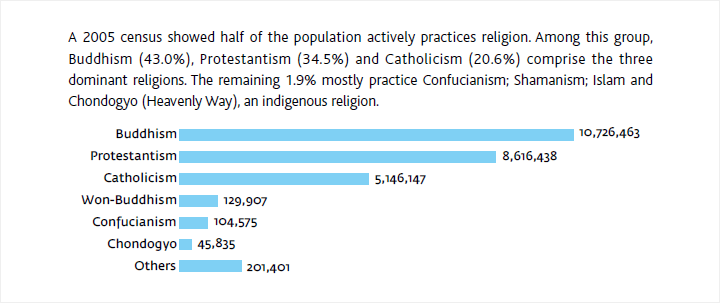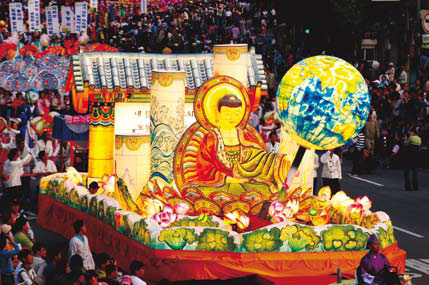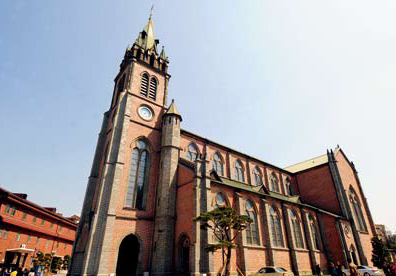Unlike some cultures where a single religion is dominant, Korean culture includes a wide variety of religious elements that have shaped the people’s way of thinking and behavior. In the early stages of history in Korea, religious and political functions were combined but they later became distinct.
Historically, Koreans lived under the influences of Shamanism, Buddhism, Taoism or Confucianism, and in modern times, the Christian faith has made strong inroads into the country, bringing forth yet another important factor that may change the spiritual landscape of the people. The rapid pace of industrialization which occurred within a couple of decades compared to a couple of centuries in the West, has brought about considerable anxiety and alienation while disrupting the peace of mind of Koreans, encouraging their pursuit of solace in religious activities. As a result, the population of religious believers has expanded markedly with religious institutions emerging as influential social organizations.
Freedom of religion is guaranteed by the Constitution in Korea. According to a 2005 social statistics survey, 53.1% of Koreans follow a specific religious faith. Buddhists account for some 43% of the religious population, followed by Protestants at 34.5% and Catholics at 20.6%.
Religion

Unit: persons
Source: Statistics Korea www.kostat.go.kr
Buddhism
Buddhism is a highly disciplined philosophical religion which emphasizes personal salvation through rebirth in an endless cycle of reincarnation.
Buddhism was introduced to Korea in A.D. 372 during the Goguryeo Kingdom period by a monk named Sundo who came from the Qian Qin Dynasty in China. In 384, monk Malananda brought Buddhism to Baekje from the Eastern Jin State of China. In Silla, Buddhism was disseminated by a monk Ado of Goguryeo by the mid-fifth century. Buddhism seems to have been well supported by the ruling people of the Three Kingdoms because it was suitable as a spiritual prop for the governing structure with Buddha, like the king, serving as a venerated symbol of authority.
Under royal patronage, many temples and monasteries were constructed and believers grew steadily. By the sixth century monks and artisans were migrating to Japan with scriptures and religious artifacts to form the basis of early Buddhist culture there.
By the time Silla unified the peninsula in 676, it had embraced Buddhism as the state religion, though the government systems were along Confucian lines. Royal preference for Buddhism in this period produced a magnificent flowering of Buddhist arts and temple architecture, including Bulguksa Temple and other relics in Gyeongju, the capital of Silla. The state cult of Buddhism began to deteriorate as the nobility indulged in a luxurious lifestyle. Buddhism then established the Seon (Zen) sect to concentrate on finding universal truth through a life of frugality.
Lotus Lantern Festival – A lantern festival is held to commemorate the birth of Buddha on a weekend before the date (April 8th on the lunar calendar).www.llf.or.kr
The rulers of the succeeding Goryeo Dynasty were even more enthusiastic in their support of the religion. During Goryeo, Buddhist arts and architecture continued to flourish with unreserved support from the aristocracy. The Tripitaka Koreana was produced during this period. When Yi Seong-gye, founder of the Joseon Dynasty, staged a rebellion and had himself proclaimed king in 1392, he tried to remove all influences of Buddhism from the government and adopted Confucianism as the guiding principles for state management and moral decorum. Throughout the five-century reign of Joseon, any effort to revive Buddhism was met with strong opposition from Confucian scholars and officials.
When Japan forcibly took over Joseon in 1910, it made attempts to assimilate Korean Buddhist sects with those of Japan. These attempts, however, failed and even resulted in a revival of interest in native Buddhism among Koreans. The past few decades have seen Buddhism undergo a sort of renaissance involving efforts to adapt to the changes of modern society. While the majority of monks remain in mountainous areas, absorbed in self-discipline and meditation, some come down to the cities to spread their religion. There are a large number of monks conducting religious research at universities in and outside Korea. Seon (meditation-oriented Korean Buddhism) has been noticeably growing with many foreigners following in the footsteps of revered Korean monks through training at Songgwangsa Temple in Jeollanam-do Province and Seon centers in Seoul and provincial cities.
Confucianism
Founded by Confucius in the 6th century B.C., Confucianism is more a moral code of conduct than a religious belief. It is a system of ethical precepts – benevolent love, righteousness, decorum and wise leadership – designed to inspire and preserve the proper management of family and society. Still, Confucianism can be seen as a religion without a god because as the ages have passed, some followers have canonized the founding sage and religiously follow the principal disciplines of his system.
Confucianism was introduced along with the earliest specimens of Chinese written materials around the beginning of the Christian era. The Three Kingdoms of Goguryeo, Baekje and Silla all left records that indicate the early existence of Confucian influence. In Goguryeo, a state university called Taehak was established in 372 and private Confucian academies were founded in its provinces. Baekje set up such institutions even earlier.
Unified Silla sent delegations of scholars to Tang China to observe the workings of the Confucian institutions firsthand and to bring back voluminous writings on the subjects. For the Goryeo Dynasty in the 10th century, Buddhism was the state religion, and Confucianism formed the philosophical and structural backbone of the state. The civil service examination of Gwageo, adopted after the Chinese system in the late 10th century, greatly encouraged studies in the Confucian classics and deeply implanted Confucian values in Korean minds.
The Joseon Dynasty, which was established in 1392, accepted Confucianism as the official ideology and developed a Confucian system of education, ceremony and civil administration. When Western powers and Japan began using military incursions in the late 19th century to pressure Korea to open up, the Confucianists raised “righteous armies” to fight against the aggressors.
Efforts were also made to reform Confucianism and adapt it to the changing conditions of the times. These reformists accepted the new Western civilization and endeavored to establish a modern, independent government. Also, during Japan’s colonial rule of Korea, Confucian reformists joined many independence movements to fight against imperial Japan. Today, Confucian ancestral worship is still prevalent and filial piety is highly revered as a virtue in Korean society.
Catholicism
The tide of Christian mission activities reached Korea in the 17th century when copies of Catholic missionary Matteo Ricci’s works in Chinese were brought back from Beijing by the annual tributary mission to the Chinese emperor. Along with religious doctrine, these books included aspects of Western learning such as the solar calendar and other matters that attracted the attention of the Joseon scholars of Silhak, or the School of Practical Learning.
Myeong-dong Cathedral, central Seoul www.mdsd.or.kr
By the 18th century, there were several converts among these scholars and their families. No priests entered Korea until Chinese priest Zhou Wenmo visited Korea in 1794. The number of converts continued to increase, although the propagation of foreign religions on Korean soil was still technically against the law and there were sporadic persecutions. By the year 1865, two years after the xenophobic prince regent Daewongun came to power, a dozen priests presided over a community of some 23,000 believers.
In 1925, 79 Koreans who had been martyred during the Joseon Dynasty persecutions were beatified at St. Peter’s Basilica in Rome, and in 1968 an additional 24 were honored in the same way.
During and after the Korean War (1950-53), the number of Catholic relief organizations and missionaries increased. The Korean Catholic Church grew quickly and its hierarchy was established in 1962. The Roman Catholic Church in Korea celebrated its bicentennial with a visit to Seoul by Pope John Paul II and the canonization of 93 Korean and 10 French missionary martyrs in 1984.
It was the first time that a canonization ceremony was held outside the Vatican. This gave Korea the fourth-largest number of Catholic saints in the world.
Protestantism
In 1884, Horace N. Allen, an American medical doctor and Presbyterian missionary, arrived in Korea. Horace G. Underwood of the same denomination and Methodist Episcopal missionary, Henry G. Appenzeller, came from the United States the next year. They were followed by missionaries from other Protestant denominations. The foreign missionaries contributed to Korean society by rendering medical services and education as a means of disseminating their beliefs. Korean Protestants like Dr. Seo Jae-pil, Yi Sang-jae and Yun Chi-ho, all independence leaders, committed themselves to political causes.
The Protestant private schools, such as Yonhi and Ewha, functioned to enhance nationalist thought among the public. The Seoul Young Men’s Christian Association (YMCA) was founded in 1903 along with other such Christian organizations. The organizations carried out socio-political programs actively, encouraging the inauguration of similar groupings of young Koreans. These groups pursued not only political and educational causes but also awakened social consciousness against superstitious practices and bad habits, while promoting the equality of men and women, elimination of the concubine system, and simplification of ceremonial observances.
Indigenous Religions
The fall of the Joseon Dynasty and the coming of the Japanese occupation spurred the formation of several new faiths.
Won-Buddhism was founded to lead all sentient beings drowning in the sea of suffering to an immeasurable paradise. It is a faith based on moral training and fortitude and the quest for truth. The name Won-Buddhism, Wonbulgyo in Korean, is a compound of words signifying truth, enlightenment and teaching: “Won” means unitary circle and symbolizes the ultimate truth. “Bul” means to enlighten, and “gyo” means to teach the truth. Therefore, Won-Buddhism is a religion that calls for truthful enlightenment and the application of that knowledge in daily life.
Chondogyo was initiated as a social and technological movement against rampant competition and foreign encroachment in the 1860s. At that time, it was called Donghak (Eastern learning) in contrast to “Western learning.” The principle of Chondogyo is Innaecheon which identifies man with “Haneullim,” the God of Chondogyo, even though he is not exactly the same as God. Every man bears Haneullim in his mind and this serves as the source of his dignity, while spiritual training makes him one with the divine.
Daejonggyo, a nationalist religion that worshiped Dangun, played a critical role in leading the Korean independence movement during the 1910s and 20s.
Islam
Although there were trade and diplomatic exchanges between the Goryeo Dynasty and the Islamic world, these contacts dried up during the Joseon Dynasty. The first Koreans to be introduced to Islam in more recent times were laborers dispatched to northeastern China in the early 20th century as part of imperial Japan’s colonial policy. A handful of converts returned home after World War II. They lived alone with their new faith until the Korean War brought Turkish troops here on the side of the UN forces. The Turks invited the Korean converts to join them in prayers. Korean Islam’s inaugural service was held in September 1955, followed by the election of the first Korean imam. The Korean Islamic Society was expanded and reorganized as the Korean Muslim Federation in 1967, and a central mosque was dedicated in Seoul in 1976.


